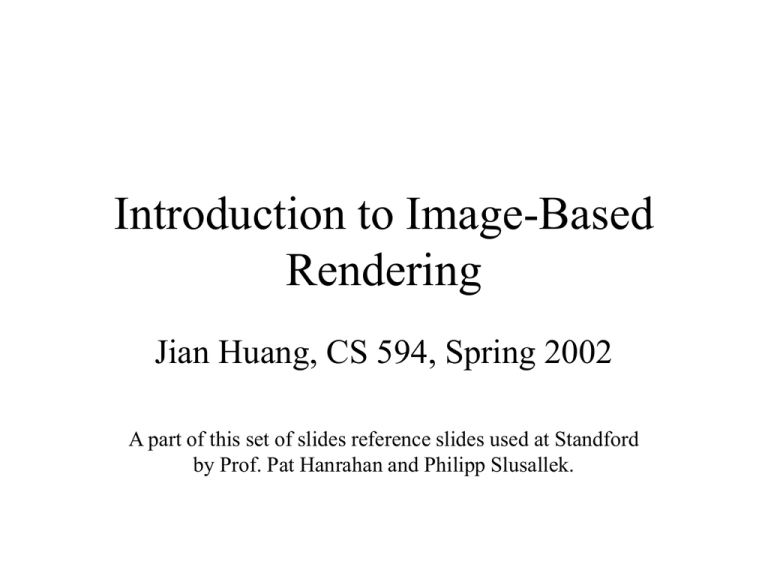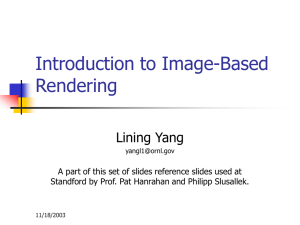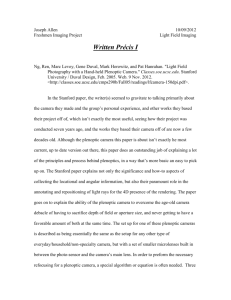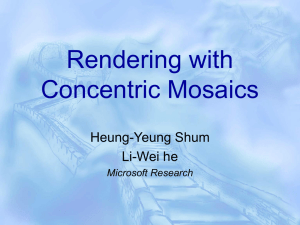Introduction to Image-Based Rendering Jian Huang, CS 594, Spring 2002
advertisement

Introduction to Image-Based Rendering Jian Huang, CS 594, Spring 2002 A part of this set of slides reference slides used at Standford by Prof. Pat Hanrahan and Philipp Slusallek. What is Image- Based Rendering? • Not just using images on geometry (akin to texture mapping) • Built on desire to bypass the manual modeling phase • Use images (of some kind) for modeling and rendering Types of IBR • Panoramas/Image Mosaics/Light Fields, Lumigraph – QuicktimeVR – Concentric Mosaics, light fields/lumigraph • View Interpolation • Model based methods – Depth Images – Geometry from Images Plenoptic Function • Plenoptic function (7D) depicts light rays passing through: – – – – center of camera at any location (x,y,z) at any viewing angle ( , ) for every wavelength ( ) for any time ( t ) Limiting Dimensions of Plenoptic Functions • Plenoptic modeling (5D) : ignore time & wavelength • Lumigraph/Lightfield (4D) : constrain the scene (or the camera view) to a bounding box • 2D Panorama : fix viewpoint, allow only the viewing direction and camera zoom can be changed Limiting Dimensions of Plenoptic Functions • Concentric mosaics (3D) : index all input image rays in 3 parameters: radius, rotation angle and vertical elevation Apple’s QuickTime VR Outward Inward Mars Pathfinder Panorama Creating a Cylindrical Panorama From www.quicktimevr.apple.com Commercial Products – QuickTime VR, LivePicture, IBM (Panoramix) – VideoBrush – IPIX (PhotoBubbles), Be Here, etc. Light Field and Lumigraph • Take advantage of empty space to – reduce Plenoptic Function to 4D Capturing Lightfields • Need a 2D set of (2D) images • Choices: – – – – Camera motion: human vs. computer Constraints on camera motion Coverage and sampling uniformity Aliasing Lightfield Parameterization • Point / angle • Two points on a sphere • Points on two planes • Original images and camera positions Two Plane Parametrization Focal plane (st) Camera plane (uv) Object Reconstruction • Light Field • Key Ideas: 4D function - Valid outside convex hull 2D slice = image - Insert to create - Extract to display Inward or outward Lightfields • Advantages: – Simpler computation vs. traditional CG – Cost independent of scene complexity – Cost independent of material properties and other optical effects • Disadvantages: – Static geometry – Fixed lighting – High storage cost Concentric Mosaics • Concentric mosaics : easy to capture, small in storage size Concentric Mosaics • A set of manifold mosaics constructed from slit images taken by cameras rotating on concentric circles Sample Images Rendering a Novel View Construction of Concentric Mosaics • Synthetic scenes – uniform angular direction sampling – square root sampling in radial direction Construction of Concentric Mosaics (2) • Real scenes Bulky, costly Cheaper, easier Construction of Concentric Mosaics (3) • Problems with single camera: – Limited horizontal fov – Non-uniform spatial horizontal resolution • Resampling necessary – bilinear is better than point sampling • Video sequence can be compressed with VQ and entropy encoding (25X) • Compressed stream gives 20fpx on PII300 Results Results (2) View Interpolation • Sprites/Imposters with Depth – Better image warping: • Wider range of reuse • Backward mapping only with homograph – New mapping: • Stored depth map • Forward map depth map (approximate geometry) • Backward mapping of color using depth information d d’ d’ Mapping with Depth • Forward Mapping: – Holes and aliasing I1 d1 I2 (I2 ) Mapping with Depth • Backward Mapping: – What is d? I1 (I2) I2 d2 Mapping with Depth • Solution: – Forward map depth – Reconstruct approximate geometry – Backward map color I1 (I2) I2 d2 Layered Depth Images • Idea: – Handle disocclusion – Store invisible geometry in depth images • Data structure: – Per pixel list of depth samples – Per depth sample: • RGBA • Z • Encoded: Normal direction, distance – Pack into cache lines Layered Depth Images • Computation: – Incremental warping computation – Implicit ordering information • Process in up to four quadrant – Splat size computation • Table lookup • Fixed splat templates – Clipping of LDIs Layered Depth Images Model-based IBR • Basic Idea: Sparse set of images [Debevec’97, Pulli’96] • Overview: – Approximate Modeling • Photogrammetric modeling • Triangulated depth maps – View-dependent Texture Mapping • Weighting • Hardware accelerated rendering – Model-based Stereo • Details from stereo algorithms Hybrid Approach • Courtesy: P. Debevec Approximate Modeling • User-assisted photogrammetry [Debevec ‘97]: – Based on “Structure from Motion” – Use constraints in architectural models • Approach: – – – – – Simple block model Constraints reduce DOF Matching based on lines Non-linear optimization Initial Camera Positions Approximate Modeling: Block Model Courtesy: P. Debevec Approximate Modeling • Active Light: – – – – Calibrated camera and projector Plane of light and triangulation Registration of multiple views Triangulation of point cloud Camera Projector Approximate Modeling Projecting Images • Technique: – – – – – Known camera positions Projective texture mapping Shadow buffer for occlusions Blending between textures Filling in Visibility • Projecting Images Projecting Images • Simple compositing vs. blending • Blending: – Select “best” image • • • • • closeness to viewing direction distance to border sampling density [Pulli] deletion of features Some computation in HW – Smooth transition between pixels and frames • Alpha blending, soft Z-buffer, confidence Projecting Images • Closeness to viewing direction: – Triangulate the Hemisphere • Delaunay triangulation of viewing directions • Regular triangulation: label each vertex with best view – Interpolate based on barycentric coordinates Blending of Textures Model-Based Stereo • Problems with conventional stereo algorithms: – Correspondences are difficult to find – Large disparities – Foreshortening, projective distortions • Approach: – Use approximate geometry to reproject one image – Compute disparity of warped image • Significant smaller disparity and foreshortening Model-Based Stereo Model-Based Stereo Model-Based Stereo Demos •




